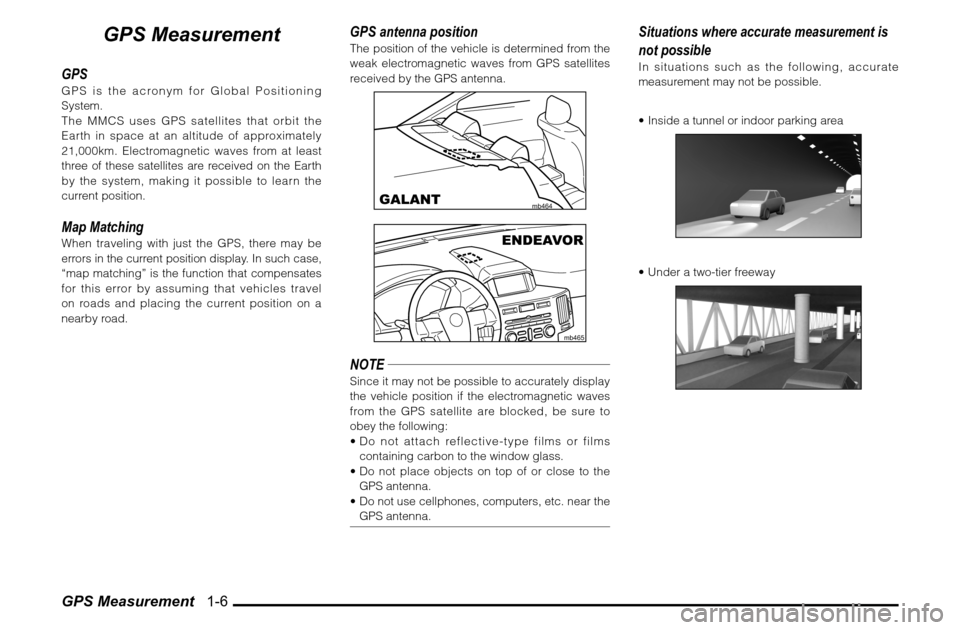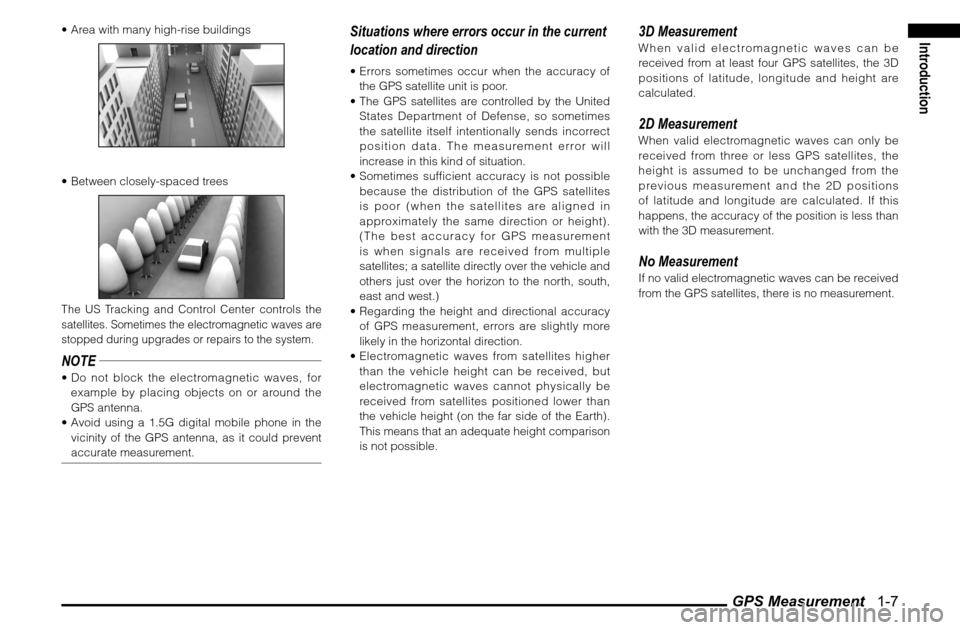GPS Antenna MITSUBISHI ENDEAVOR 2011 1.G MMCS Manual
[x] Cancel search | Manufacturer: MITSUBISHI, Model Year: 2011, Model line: ENDEAVOR, Model: MITSUBISHI ENDEAVOR 2011 1.GPages: 101, PDF Size: 8.77 MB
Page 9 of 101

GPS Measurement 1-6
GPS Measurement
GPSGPS is the acronym for Global Positioning
System.
The MMCS uses GPS satellites that orbit the
Earth in space at an altitude of approximately
21,000km. Electromagnetic waves from at least
three of these satellites are received on the Earth
by the system, making it possible to learn the
current position.Map MatchingWhen traveling with just the GPS, there may be
errors in the current position display. In such case,
“map matching” is the function that compensates
for this error by assuming that vehicles travel
on roads and placing the current position on a
nearby road.
GPS antenna positionThe position of the vehicle is determined from the
weak electromagnetic waves from GPS satellites
received by the GPS antenna.
mb464
GALANT
mb465
ENDEAVOR
NOTESince it may not be possible to accurately display
the vehicle position if the electromagnetic waves
from the GPS satellite are blocked, be sure to
obey the following:
Do not attach reflective-type films or films
containing carbon to the window glass.
Do not place objects on top of or close to the
GPS antenna.
Do not use cellphones, computers, etc. near the
GPS antenna.
Situations where accurate measurement is
not possibleIn situations such as the following, accurate
measurement may not be possible.
Inside a tunnel or indoor parking area Under a two-tier freeway
Page 10 of 101

GPS Measurement 1-7
Introduction
Area with many high-rise buildings Between closely-spaced trees The US Tracking and Control Center controls the
satellites. Sometimes the electromagnetic waves are
stopped during upgrades or repairs to the system.NOTE Do not block the electromagnetic waves, for
example by placing objects on or around the
GPS antenna.
Avoid using a 1.5G digital mobile phone in the
vicinity of the GPS antenna, as it could prevent
accurate measurement.
Situations where errors occur in the current
location and direction Errors sometimes occur when the accuracy of
the GPS satellite unit is poor.
The GPS satellites are controlled by the United
States Department of Defense, so sometimes
the satellite itself intentionally sends incorrect
position data. The measurement error will
increase in this kind of situation.
Sometimes sufficient accuracy is not possible
because the distribution of the GPS satellites
is poor (when the satellites are aligned in
approximately the same direction or height).
(The best accuracy for GPS measurement
is when signals are received from multiple
satellites; a satellite directly over the vehicle and
others just over the horizon to the north, south,
east and west.)
Regarding the height and directional accuracy
of GPS measurement, errors are slightly more
likely in the horizontal direction.
Electromagnetic waves from satellites higher
than the vehicle height can be received, but
electromagnetic waves cannot physically be
received from satellites positioned lower than
the vehicle height (on the far side of the Earth).
This means that an adequate height comparison
is not possible.
3D MeasurementWhen valid electromagnetic waves can be
received from at least four GPS satellites, the 3D
positions of latitude, longitude and height are
calculated.2D MeasurementWhen valid electromagnetic waves can only be
received from three or less GPS satellites, the
height is assumed to be unchanged from the
previous measurement and the 2D positions
of latitude and longitude are calculated. If this
happens, the accuracy of the position is less than
with the 3D measurement.No MeasurementIf no valid electromagnetic waves can be received
from the GPS satellites, there is no measurement.